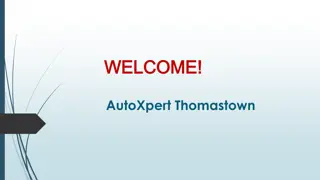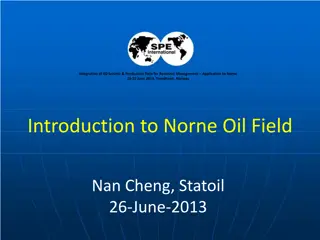Managing Multiple Purposes in Reservoir Operations
Reservoirs with multiple purposes can present challenges in balancing competing needs such as water supply, flood risk management, hydropower generation, and more. Understanding the interactions between these purposes is essential for optimizing reservoir operations and ensuring reliable water suppl
2 views • 24 slides
Reservoir Storage-Yield Analyses Using HEC-ResSim Lecture #2
This lecture covers the theory of storage-yield analyses, focusing on understanding yield, types of yield like firm yield, methods to calculate yield, and the importance of storing water for re-distribution. It delves into within-year and over-year reservoir storage concepts, illustrating the minimu
9 views • 47 slides
Reservoir Inflows and Computing Methods
Explore the methods for computing reservoir inflows, including mass balance formulas, known and unknown variables, and techniques to handle negative values. Learn about linking to HMS for hydrologic engineering, estimating local inflows, and utilizing smoothing techniques for accurate results.
1 views • 24 slides
Best Car Battery Replacement in Reservoir
Are you looking for the Best Car Battery Replacement in Reservoir? Then contact AutoXpert Thomastown. They specialise in diagnosing and repairing electrical issues in vehicles of all makes and models. Their skilled technicians use the latest diagnostic tools and techniques to ensure accurate and eff
1 views • 6 slides
Overview of Reservoir Fisheries and Aquaculture in India
Reservoir fisheries play a vital role in India's aquaculture sector, with over 19,000 reservoirs covering millions of hectares. These manmade impoundments serve various purposes like irrigation and power generation. The reservoirs are classified into small, medium, and large categories based on thei
1 views • 28 slides
Linear Reservoir Baseflow Method
The linear reservoir baseflow method utilizes linear reservoirs to simulate the movement of water infiltrated into the soil. This method models water movement from the land surface to the stream network by integrating a linear relationship between storage and discharge. Users can select from one, tw
0 views • 11 slides
Baseflow Modeling in HEC-HMS
Baseflow in HEC-HMS plays a crucial role in modeling runoff volume, consisting of groundwater flow components like interflow and baseflow. Different approaches are used to model baseflow, with HEC-HMS currently incorporating conceptual methods. The response times for interflow and baseflow differ, i
2 views • 7 slides
Reservoir Fisheries and Aquaculture in India
Reservoir fisheries play a crucial role in India, with over 19,000 reservoirs covering millions of hectares. These manmade impoundments serve various purposes such as irrigation and power generation. They are classified based on size into small, medium, and large reservoirs, each with distinct chara
0 views • 28 slides
Vector Relationships and Pathogen Transmission
Understanding mechanical and biological vectors, reservoir hosts, and their role in disease transmission is crucial for effective disease control. Mechanical vectors like flies can transfer pathogens without getting infected, while biological vectors like mosquitoes carry pathogens that reproduce in
1 views • 5 slides
Geometric Modeling in CAD
Geometric modeling in computer-aided design (CAD) is crucially done in three key ways: wireframe modeling, surface modeling, and solid modeling. Wireframe modeling represents objects by their edges, whereas surface modeling uses surfaces, vertices, and edges to construct components like a box. Each
2 views • 37 slides
Gastric Motility and Secretion in the Stomach
The stomach plays a crucial role in food processing, acting as a reservoir, preparing chyme for digestion, and facilitating absorption. Divided anatomically and physiologically, it functions as a storage unit and mixing chamber for food. Key motor functions include storage, preparation for digestion
0 views • 49 slides
An Overview of Reservoir Types and Purposes
Reservoirs play a crucial role in managing water resources for various purposes like irrigation, hydroelectric power generation, flood control, and more. This article explores different types of reservoirs such as storage, flood control, retarding, and detention reservoirs, along with their function
1 views • 49 slides
Introduction to Dynamic Structural Equation Modeling for Intensive Longitudinal Data
Dynamic Structural Equation Modeling (DSEM) is a powerful analytical tool used to analyze intensive longitudinal data, combining multilevel modeling, time series modeling, structural equation modeling, and time-varying effects modeling. By modeling correlations and changes over time at both individu
3 views • 22 slides
Integrated Reservoir Characterization in Semliki Basin, Albertine Graben
Quantitative reservoir characterization using rock physics, seismic, and geological constraints is crucial for hydrocarbon prospect evaluation. This study by Nakajigo Joan explores the integration of these disciplines in the Semliki Basin to improve reservoir property delineation and reduce uncertai
1 views • 24 slides
Reservoir Operation Schemes: Guide Curves and Rules
Delve into the intricacies of reservoir operations through concepts like guide curves, zones, rules, and operation sets. Discover the essential elements that govern the decision-making process for storing and releasing water from reservoirs, ensuring optimal management and resource utilization.
1 views • 15 slides
Geomechanical Effects of Oilfield Chemicals on Sand Failure in Reservoir Rocks
This study by Elizabeth O. Wuyep et al. explores the geomechanical effects of oilfield chemicals on sand failure in reservoir rocks. It discusses the role of oilfield chemicals, limitations of previous works, experimental flow chart, and static saturation tests. The research emphasizes the need for
0 views • 25 slides
RCRL Prospective Research Directions in Carbonate Reservoir Characterization
The RCRL group at the University of Texas at Austin specializes in research on carbonate reservoirs at various scales, from nanopores to basin architecture. They focus on developing predictive relationships and tools for reservoir characterization based on subsurface datasets and outcrop analogs. Th
1 views • 12 slides
Utilizing Integrated Measurements for Reservoir Fluid Characterization while Drilling
This presentation focuses on the integration of surface and downhole measurements to characterize reservoir fluids while drilling. Topics covered include mud gas data acquisition and evaluation, gas analysis while drilling, challenges in tight and abrasive formations, and environmental corrections s
0 views • 23 slides
Estimating Original Gas In Place for Reservoir Management
This study focuses on utilizing GIS technology to estimate Original Gas In Place (OGIP) for reservoir management, with the aim of enhancing oil and gas production, reducing risks, and optimizing recovery. The project outlines the background of reservoir management, introduces the process of volumetr
0 views • 24 slides
Hydrogeology and Water Resource Management Problems
The content contains four challenging problems related to hydrogeology, evaporation, watershed hydrology, and flood control reservoir operations. It covers topics such as water table rise, evaporation rate calculation, unit hydrograph analysis, detention basin filling, and reservoir inflow routing.
0 views • 4 slides
Gastric Motility and Secretion in the Stomach: Functions and Division Overview
The stomach plays crucial roles in food storage, chyme preparation, water absorption, and slow emptying into the small intestine. Its motor functions include maintaining a reservoir, mixing food, and facilitating relaxation reflexes for optimal digestion. Anatomically and physiologically, the stomac
1 views • 46 slides
Multiphase Flows in the Upstream: A Comprehensive Overview
This content delves into the complexities of multiphase flows in the upstream sector, covering topics such as reservoir management, drilling, subsurface imaging, and reservoir modeling. It explores the challenges of multi-scale phenomena, multi-physics interactions, uncertainty, and inversion in the
1 views • 4 slides
Comprehensive Integration of 4D Seismic & Production Data for Norne Reservoir Management
This presentation by Nan Cheng of Statoil in 2013 focuses on the integration of 4D seismic and production data for reservoir management at the Norne Oil Field in Norway. Covering topics such as field structure, zones, official reserves, production profiles, and subsea development solutions, it provi
0 views • 17 slides
Snake River Waters: A Visual Journey
Embark on a visual adventure through images showcasing the beauty of Snake River and CJ Strike Reservoir. Witness the serene seepage study updates, captivating views of CJ Strike Reservoir with its white caps, and the picturesque landscapes of Snake River near Murphy and Bliss. Let these stunning im
0 views • 6 slides
SPE Reservoir Characterisation and Simulation Conference 2023 in Abu Dhabi, UAE
Explore the latest advancements in reservoir characterisation and simulation at the SPE Conference in Abu Dhabi on 24-26 January 2023. Engage with industry experts, discover cutting-edge technologies, and network with peers in this premier event dedicated to the oil and gas sector. The conference fe
0 views • 6 slides
Three-Phase Relative Permeabilities in Reservoir Engineering
Explore the application, correlations, and traditional assumptions of three-phase relative permeabilities in reservoir engineering. Learn about saturation-dependencies, occupancy models, and the challenges of measuring three-phase relative permeabilities. Discover how to calculate three-phase permea
2 views • 14 slides
Reservoir Connectivity and Its Impact on Recovery Models
Sand connectivity plays a crucial role in reservoir recovery, with reservoir properties' heterogeneity influencing connectivity. Field-based studies in the USA focus on water-flooding and injector-producer connectivity in channel sand reservoirs. Geostatistical models using percolation theory help s
0 views • 4 slides
Reservoir Modeling Using Gaussian Mixture Models
In the field of reservoir modeling, Gaussian mixture models offer a powerful approach to estimating rock properties such as porosity, sand/clay content, and saturations using seismic data. This analytical solution of the Bayesian linear inverse problem provides insights into modeling reservoir prope
0 views • 10 slides
Reservoir Road Surgery PPG Meeting Overview
In this overview, discover the changes implemented at Reservoir Road Surgery since COVID-19, including accessibility measures, doctor appointments, phone operations, prescription options, and upcoming improvements. Learn about the increased availability of GPs, appointment procedures, and enhanced p
0 views • 11 slides
Evaluation of HIV-1 Reservoir Size and bNAb Susceptibility
This study examines HIV-1 reservoir size and susceptibility to broadly neutralizing antibodies in individuals who initiated antiretroviral therapy (ART) during acute or chronic infection. It investigates the impact of early ART initiation on reservoir characteristics, essential for developing effect
0 views • 16 slides
Developing Digital Informational Model for Well Productivity Estimation through Markov Processes Tools
Gubkin University presents a study on developing a digital informational model for estimating well productivity using Markov processes tools in oil and gas production. The research covers industrial data processing, reservoir model uncertainty evaluation, and organizational process planning. It emph
0 views • 17 slides
Probabilistic Particle Swarm Optimization for Using Prior Information
In this study by Jaehoon Lee and Tapan Mukerji from Stanford Center for Reservoir Forecasting, they introduce Pro-PSO, a technique that leverages prior knowledge and hierarchical parameters to enhance optimization processes. The method combines the strengths of particle swarm optimization with proba
0 views • 24 slides
Developing a Long-term Global Reservoir Product Series by Fusing Multi-Satellite Observations
This presentation discusses the development of a comprehensive global reservoir product series through the integration of multi-satellite observations. The focus is on leveraging MODIS/VIIRS data to improve our understanding of reservoir dynamics and water resource management on a global scale.
0 views • 22 slides
Reservoir Routing and Hydrograph Alterations
Explore how reservoirs and streamflow routing affect runoff hydrographs, learn about reservoir system components, outlet specification, and the level-pool routing method. Understand the impact of inflows, storage characteristics, and outlet properties on reservoir output.
0 views • 7 slides
Understanding Reservoir Models and Flux Dynamics in Earth Science
Explore the concept of reservoir models and flux dynamics illustrated by a cascade of lakes in Computational Earth Science. Learn how the reservoir flux depends on various factors and its implications on the system. Dive into differential equations and feedback mechanisms affecting reservoir dynamic
0 views • 26 slides
Understanding Three-Phase Relative Permeability in Reservoir Engineering
Explore the complexities of three-phase relative permeability in reservoir engineering, including applications, correlations, traditional assumptions, and saturation dependencies. Discover how water-wet and gas-oil systems impact permeability characteristics.
0 views • 14 slides
Introduction to Stream Computing and Reservoir Sampling
Explore the concepts of stream computing and reservoir sampling, essential for handling infinite data streams efficiently. Learn about applications in mining query streams, sensor networks, and the challenges of one-pass models and sampling methods.
0 views • 16 slides
Gastric Motor Functions and Physiology Explained in Detail
Explore the intricate details of gastric motility and secretion, including the storage of food, chyme preparation, water absorption, and slow chyme emptying. Learn about the anatomical and physiological divisions of the stomach, motor functions such as storage and mixing, and the role of the gastric
0 views • 47 slides
Discrete Event Modeling vs. Agent-Based Modeling: A Comparative Analysis
Explore the differences between discrete event modeling and agent-based modeling in this informative presentation. Discover how these modeling approaches vary in defining system behavior, individual autonomy, and global outcomes, with real-world examples and accompanying research paper. Understand t
1 views • 8 slides
Reservoir Management at Norne Oil Field: Integration of 4D Seismic and Production Data
Explore the application of integrating 4D seismic and production data for reservoir management at Norne Oil Field. Learn about the field's production history, high-quality reservoir characteristics, structure and zones, official reserves and production profiles, and subsea development solutions.
0 views • 17 slides







































